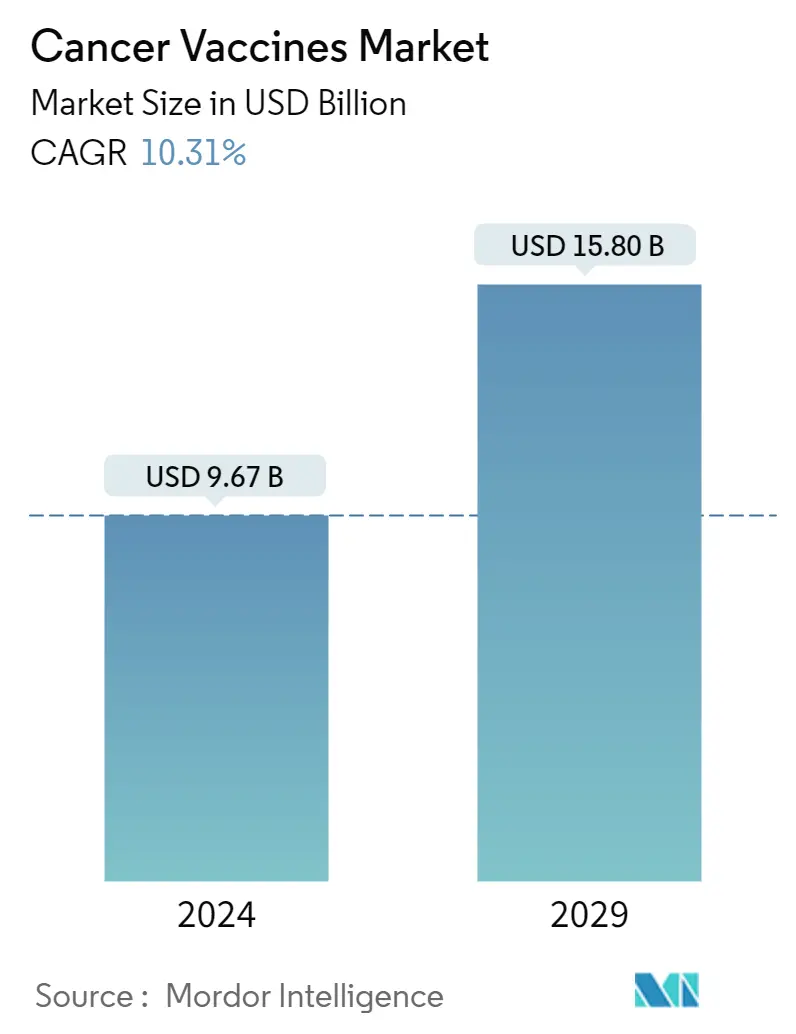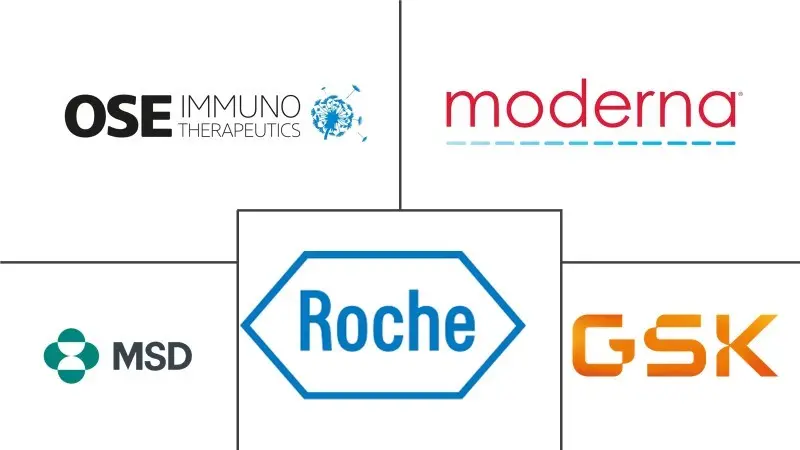Market Size of Cancer Vaccines Industry

| Study Period | 2019 - 2029 |
| Market Size (2024) | USD 9.67 Billion |
| Market Size (2029) | USD 15.80 Billion |
| CAGR (2024 - 2029) | 10.31 % |
| Fastest Growing Market | Asia Pacific |
| Largest Market | North America |
Major Players
*Disclaimer: Major Players sorted in no particular order |
Cancer Vaccines Market Analysis
The Cancer Vaccines Market size is estimated at USD 9.67 billion in 2024, and is expected to reach USD 15.80 billion by 2029, growing at a CAGR of 10.31% during the forecast period (2024-2029).
The COVID-19 pandemic had an adverse effect on the global economy and healthcare system. Pharmaceuticals, medical gadgets, and biotechnological items were all affected by the worldwide lockdown. Research and development, on the other hand, took center stage. Many countries stopped their asymptomatic cancer screening programs due to the need to divert medical personnel and resources to the pandemic response. In March 2020, the governments of Wales and Scotland stopped funding breast, cervical, and bowel cancer screening programs. The Centers for Medicare & Medicaid Services in the United States encouraged healthcare institutions to delay screenings because they were a low-priority service. Several clinical experiments were put on hold due to COVID-19, at least during the pandemic's peak. Apart from the potential health benefits for those currently enrolled in studies, a phase 3 cancer clinical study typically costs at least USD 20 million. As a result, the production of cancer vaccines and other current clinical trials was suspended throughout the pandemic, and it is predicted that the market suffered as a result.
On the other hand, according to a JCO Global Oncology Journal article published in October 2021, the Dubai Health Authority reviewed and adjusted all center-specific guidelines and policies for each center-specific cohort to maintain high-quality oncology care throughout the nation. Other quality requirements included preventing interruptions of IV chemotherapy services, increasing the use of granulocyte colony-stimulating factor support, and providing coverage for antibiotics. The expansion of the industry is also being fueled by such government initiatives. Therefore, the market first witnessed a short-term negative impact due to the shift in research focus toward the development of COVID-19 vaccines. However, the relaxation of strict regulations during the post-pandemic period is expected to contribute to the growth of the market.
Certain factors driving the growth of the cancer vaccine market include the increasing number of cancer cases, rising investments and government funding in developing cancer vaccines, and technological developments in cancer vaccines. As per the International Agency for Research on Cancer's published GLOBOCAN 2020 report, which estimated the incidence and mortality of 36 cancers in 185 countries globally, there were an estimated 19,292,789 new cases of cancer diagnosed in 2020, and about 9,958,133 people died due to cancer all over the world. From the total number of diagnosed cancer cases, 10,065,305 cases were reported in males and 9,227,484 cases were reported in females. The incidence of cancer cases in males was expected to reach 15,585,096 by 2040 and 13,302,846 in females by 2040. Such an increasing incidence of cancer among the global population is expected to drive the growth of the market. Similarly, as per the data published by the European Cancer Information System in 2020, the estimated incidence of non-melanoma skin cancer in 2020 was 2,681,958 and was expected to be 3,244,076 by 2040. Such an increasing incidence of cancer in various countries is expected to drive the demand for cancer vaccines, which is expected to propel market growth over the forecast period.
Cancer vaccines play a vital role in the maintenance of the immune system, as they are considered to be biological response modifiers. These cancer vaccines target the infectious agents that may cause cancer through the production of antibodies. Moreover, as the number of cancer cases increases, the development of new cancer vaccines is also increasing for the treatment and prevention of the disease. For instance, in March 2021, eTheRNA, a Belgian-based immunotherapy company, received a USD 6.87 million grant from the European Commission to accelerate the clinical development of mRNA-based vaccines for cervical cancers. Furthermore, in November 2020, Moderna Inc. released interim data from the expansion cohort of its ongoing Phase 1 study of its mRNA personalized cancer vaccine (PCV), mRNA-4157, in combination with Merck's Keytruda, and results demonstrated that the vaccine candidate is well tolerated at all dose levels and produced responses as measured by tumor shrinkage in HPV-negative head and neck squamous cell carcinoma (HNSCC) patients.
However, the stringent regulatory issues, along with longer timelines in manufacturing vaccines and the availability of alternative therapies such as immunotherapy, act as major hindering factors in the cancer vaccine market's growth.
Cancer Vaccines Industry Segmentation
As per the scope of the report, cancer vaccines are defined as vaccines developed to prevent or treat existing cancers by strengthening the body's natural immune response system against cancer. These cancer vaccines belong to a class of substances known as biological response modifiers. These modifiers work by stimulating or restoring the immune system's ability to fight against diseases. The Cancer Vaccines Market is Segmented by Technology (Recombinant Cancer Vaccines, Whole-cell Cancer Vaccines, Viral Vector and DNA Cancer Vaccines, and Other Technologies), Treatment Method (Preventive Vaccine and Therapeutic Vaccine), Application (Prostate Cancer, Cervical Cancer, and Other Applications), and Geography (North America, Europe, Asia Pacific, Middle-east And Africa, And South America). The market report also covers the estimated market sizes and trends for 17 different countries across major regions, globally. The report offers the value (in USD million) for the above segments.
| By Technology | |
| Recombinant Cancer Vaccines | |
| Whole-cell Cancer Vaccines | |
| Viral Vector and DNA Cancer Vaccines | |
| Other Technologies |
| By Treatment Method | |
| Preventive Vaccine | |
| Therapeutic Vaccine |
| By Application | |
| Prostate Cancer | |
| Cervical Cancer | |
| Other Applications |
| Geography | ||||||||
| ||||||||
| ||||||||
| ||||||||
| ||||||||
|
Cancer Vaccines Market Size Summary
The cancer vaccines market is poised for significant growth over the forecast period, driven by an increasing incidence of cancer globally and advancements in vaccine technology. The market experienced a temporary setback due to the COVID-19 pandemic, which diverted resources and attention away from cancer research and clinical trials. However, post-pandemic recovery and government initiatives to maintain oncology care have set the stage for market expansion. The rising number of cancer cases, coupled with substantial investments and government funding in cancer vaccine development, is expected to propel market growth. Technological advancements, such as mRNA-based vaccines and recombinant DNA vaccines, are further enhancing the efficacy and appeal of cancer vaccines, contributing to their growing adoption.
North America is anticipated to be a key region for market growth, supported by its advanced healthcare infrastructure and high cancer prevalence. The United States, in particular, is witnessing a surge in demand for effective cancer therapeutics, driven by its aging population and high cancer incidence rates. The market is characterized by a consolidated landscape with major players like AstraZeneca, Bristol-Myers Squibb, and Merck & Co. Inc. actively engaging in strategic partnerships and product launches to strengthen their market presence. These dynamics, along with ongoing research and development efforts, are expected to sustain the momentum of the cancer vaccines market, offering promising opportunities for stakeholders over the coming years.
Cancer Vaccines Market Size - Table of Contents
-
1. MARKET DYNAMICS
-
1.1 Market Overview
-
1.2 Market Drivers
-
1.2.1 Growing Burden of Cancer
-
1.2.2 Rising Investments and Government Funding in the Development of Cancer Vaccines
-
1.2.3 Technological Developments in Cancer Vaccines
-
-
1.3 Market Restraints
-
1.3.1 Stringent Regulatory Guidelines and Longer Timelines Required for Manufacturing Process
-
1.3.2 Presence of Alternative Therapies
-
-
1.4 Porter's Five Force Analysis
-
1.4.1 Bargaining Power of Buyers/Consumers
-
1.4.2 Bargaining Power of Suppliers
-
1.4.3 Threat of New Entrants
-
1.4.4 Threat of Substitute Products
-
1.4.5 Intensity of Competitive Rivalry
-
-
-
2. MARKET SEGMENTATION (Market Size by Value - USD million)
-
2.1 By Technology
-
2.1.1 Recombinant Cancer Vaccines
-
2.1.2 Whole-cell Cancer Vaccines
-
2.1.3 Viral Vector and DNA Cancer Vaccines
-
2.1.4 Other Technologies
-
-
2.2 By Treatment Method
-
2.2.1 Preventive Vaccine
-
2.2.2 Therapeutic Vaccine
-
-
2.3 By Application
-
2.3.1 Prostate Cancer
-
2.3.2 Cervical Cancer
-
2.3.3 Other Applications
-
-
2.4 Geography
-
2.4.1 North America
-
2.4.1.1 United States
-
2.4.1.2 Canada
-
2.4.1.3 Mexico
-
-
2.4.2 Europe
-
2.4.2.1 Germany
-
2.4.2.2 United Kingdom
-
2.4.2.3 France
-
2.4.2.4 Italy
-
2.4.2.5 Spain
-
2.4.2.6 Rest of Europe
-
-
2.4.3 Asia Pacific
-
2.4.3.1 China
-
2.4.3.2 Japan
-
2.4.3.3 India
-
2.4.3.4 Australia
-
2.4.3.5 South Korea
-
2.4.3.6 Rest of Asia Pacific
-
-
2.4.4 Middle East and Africa
-
2.4.4.1 GCC
-
2.4.4.2 South Africa
-
2.4.4.3 Rest of Middle East and Africa
-
-
2.4.5 South America
-
2.4.5.1 Brazil
-
2.4.5.2 Argentina
-
2.4.5.3 Rest of South America
-
-
-
Cancer Vaccines Market Size FAQs
How big is the Cancer Vaccines Market?
The Cancer Vaccines Market size is expected to reach USD 9.67 billion in 2024 and grow at a CAGR of 10.31% to reach USD 15.80 billion by 2029.
What is the current Cancer Vaccines Market size?
In 2024, the Cancer Vaccines Market size is expected to reach USD 9.67 billion.

